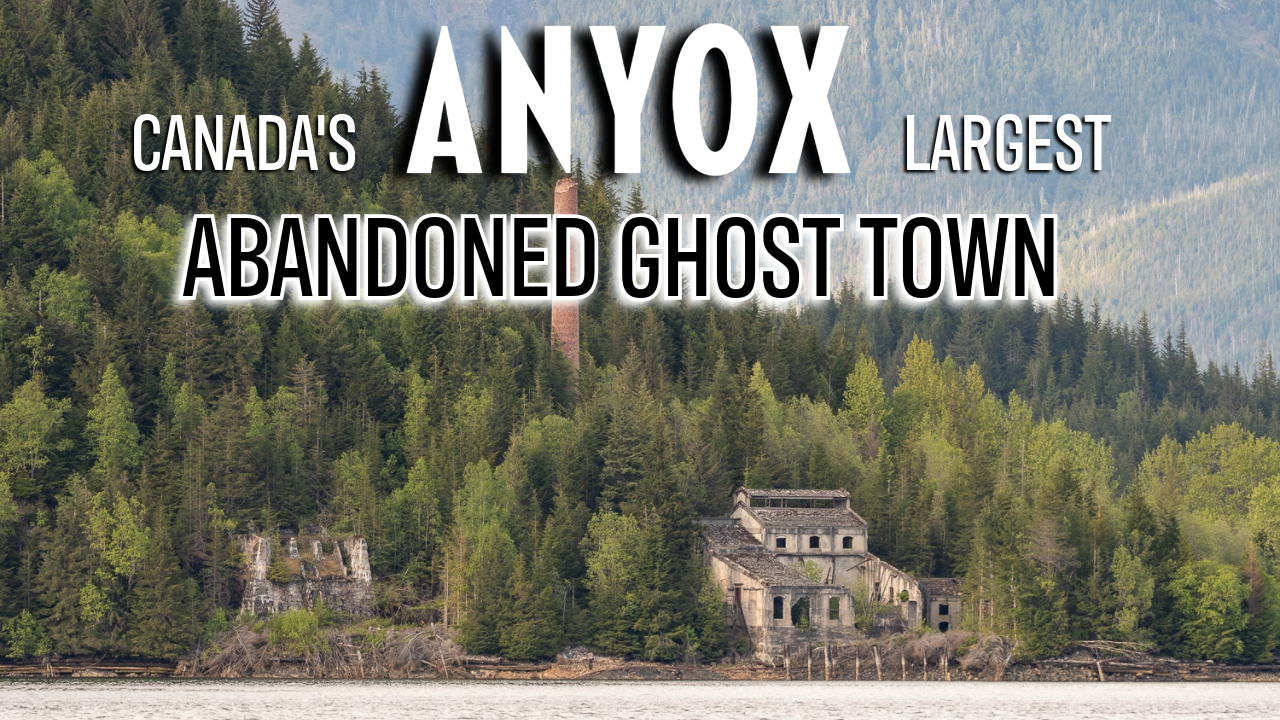Anyox, British Columbia is located approximately 60 kilometres, or 37 miles, southwest of Stewart, British Columbia and 20 kilometres, or 12 miles, from the tip of the Alaska Panhandle.
The town of Anyox was built in 1912 by a company called Granby Consolidated for mining and producing copper, silver and gold.
By 1914, Anyox had grown to a population of almost 3,000 residents, as the mine and smelter were put into full operation.
During its 25-year existence, Anyox’s mines and smelters produced 4 tonnes of gold, 230 tonnes of silver and 340,000 tonnes of copper.
Every day up to 5400 tonnes of ore were hauled across 3 kilometres of railway via 32-tonne steam and electric locomotives from the mine to the crusher and then to the concentrator near the waterfront in 75 ore cars, powered by the energy provided from the hydro dam and coal-fired generators
Huge chunks of ore would travel from the mines, to be dumped into a crusher and reduced to 8-inch pieces. It would then travel further along to the concentrator to be pulverized to a fine powder.
Hydroelectric facilities were first constructed on Anyox Creek in 1910 to support the mining and smelting operations in the adjacent Hidden Creek drainage basin
Anyox was the location of rich lodes of copper and other precious metals.. A large dam, pipelines and a powerhouse were constructed and operated to provide both electricity and compressed air to the village and smelter.
However, in 1935 the mine and the associated power project were shut down. For safety reasons, the concrete arch storage dam was breached with several small holes near its base in several locations to permit water flow and to prevent overtopping of the storage dam.
During the late 1930’s and early 1940’s large-scale salvage operations systematically removed all equipment and structural steel from Anyox to be used in the war efforts for World War Two, leaving behind the bones of the former town of 3,000 residents.
A massive forest fire caused by a lightning strike in 1946 swept clean the remains of Anyox leaving behind only the major concrete and steel structures which are still in evidence today.
The Road to Anyox
During my trip in May to Northern BC, I booked my travel to allow time to explore the area around Terrace, BC before heading out to Anyox for 5 days.
This gave me 1.5 days to seek out several waterfalls in the area, some were easy to locate after a short hike, some took up to 1 hour of driving on bumpy logging roads, some were right off the highway and some I could only photograph using my drone.
Included in this video are:
– Exstew Falls
– Wesach Falls
– Beaupre Falls
– Mannix Creek Falls
– A waterfall found off Haaland Road along the Skeena River
– A random waterfall that I spotted on distant mountains, photographed with my drone
I made a video of these two days spent driving all over the area, finding waterfalls, bears, beavers, lava beds and more!
Enjoy the adventure
Anyox:Part 1
Anyox: Then and Now
Anyox: Hydro Electric Power Plant
Construction of the Anyox hydroelectric power plant began in 1911 and was completed in 1914. The plant utilized the precipitous terrain of the Coastal Mountains, capturing the energy of the falls and channels to generate electricity. It was a cutting-edge facility for its time, producing up to 35 megawatts of power, a significant achievement that powered the mines, smelters, and homes of Anyox.
The power plant’s architecture reflected the era’s industrial grandeur. Massive turbines, transformers, and generators were housed in robust concrete and steel structures. The facility’s design showcased the blend of practicality and resilience needed to withstand the harsh coastal climate and rugged landscape.
At its peak, the hydroelectric plant symbolized progress and self-sufficiency, essential to Anyox’s prosperity. It played a crucial role in processing the extracted ore, converting it into valuable copper that was shipped worldwide. The plant’s electricity also supported the community’s daily life, from lighting homes to running schools and hospitals.
Despite its abandonment, the hydroelectric power plant at Anyox remains an important piece of industrial history. It exemplifies early hydroelectric technology and the ambitious spirit that once thrived in this remote part of British Columbia.
Besides the cemetery, the highlight of my first few days in Anyox was the hydroelectric power plant.
We arrived in Anyox on the Monday afternoon, after we were done unpacking and settling in, the very first place I went to was the power plant.
Construction of the Anyox hydroelectric power plant began in 1911 and was completed in 1914. The plant utilized the precipitous terrain of the Coastal Mountains, capturing the energy of the falls and channels to generate electricity. It was a cutting-edge facility for its time, producing up to 35 megawatts of power, a significant achievement that powered the mines, smelters, and homes of Anyox.
In the early 1930s, The Great Depression drove down the demand for copper, which was the beginning of the end for Anyox.
The mine shut down in 1935, and the town was abandoned. Salvage operations in the 1940s removed most machinery and steel from the town to be largely used for the War effort.
These salvage efforts included much of the power plant, until two forest fires caused by lightning strikes in 1942 and 1943, burned all of the remaining wood structures and wiped Anyox off the face of the earth.
What you see there now is all that remains, after years of salvage and harsh weather
